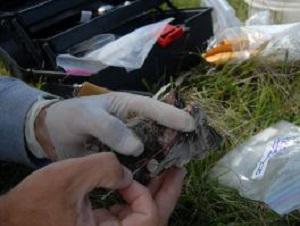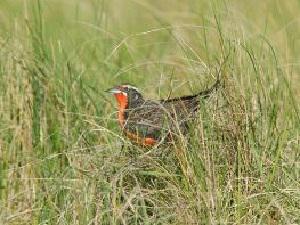Adrián Azpiroz
Other projects
7 Sep 2010
Pampas Meadowlark: Using a Flagship Species to Promote Conservation in the South American Grasslands II
9 Oct 2013
Pampas Meadowlark: Using a Flagship Species to Promote Conservation in South American Grasslands III
12 Aug 2015
Pampas Meadowlark: Using a Flagship Species to Promote Conservation in South American Grasslands IV
The project aims are to determine the Pampas Meadowlark’s precise area of occupancy and population size, start a study of the population dynamics of this species, and to promote grassland conservation among local communities through a comprehensive public awareness campaign.

Obtaining blood sample from Pampas Meadowlark fledgling.
In 2004 and 2005 I conducted a field project that focused on the threatened grassland bird assemblages of the Northern Campos of Uruguay.
/64c420e1008bfd5ec48841d40ce79b7b.jpg)
Pampas Meadowlark.
The project resulted in new data on grassland bird ecology and substantial public awareness in the area. In the new project I want to use the same general strategy (a strong field research component coupled with an education component) with two main objectives: to gather critical information on the biology of the Pampas Meadowlark (a species that has suffered one of the most severe population declines in the Pampas) and use this bird as a flagship species to continue with the promotion of grassland conservation in the region. The Pampas Meadowlark was a common and widely distributed bird in this grassland ecosystem prior to agricultural intensification. Today it is confined to 10% of its original range and only two breeding populations are known.
/b56d3a69b75061ad648834b258945874.jpg)
Cerros de Vera School.
This bird has several features that make it well suited for further conservation efforts: it is particularly sensitive to disturbance, it is restricted to the Pampas biome, and it is well known among local communities as a consequence of previous outreach activities in the study area. The species conspicuousness and site fidelity patterns make it relatively easy to study and, hopefully, the insight gained from the meadowlark will also serve to tackle the problems of other threatened species. As an education tool the bird will help highlight the conservation needs of grassland wildlife, including many fewer charismatic animals. The building of strong local support for the conservation of the Pampas Meadowlark will help trigger the necessary political will which is essential to establish long-term conservation measures.

Pampas Meadowlark Male.
The main activities of the project will be:
1) to establish the total area of occupancy of the Pampas Meadowlark by surveying all known breeding sites during two breeding seasons: and
2) to determine Pampas Meadowlark population size and productivity. Previous research has shown that the song of Pampas Meadowlark males has unique elements that make them distinguishable at the individual level.
This characteristic will serve as a precise population estimation tool. Fledglings will be banded at the end of the breeding season and subsequent regular censuses will provide information on survival rates. The education component of the project will include visits to all rural schools in the region as well as other presentations to be delivered to local communities, NGOs, and government authorities.